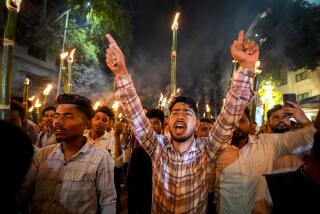India-Bangladesh deal could end suffering in border ‘enclaves’
For decades, India and Bangladesh have shared a long border, a passionate love of cricket and a deep mistrust of each other.
Among the many victims of this mutual suspicion were the residents of 162 “enclaves,” Indian communities surrounded by Bangladesh and vice versa, the result of arbitrary map-drawing as the British Empire fell in the late 1940s.
Indian Prime Minister Manmohan Singh’s two-day visit to Bangladesh starting Tuesday could end the suffering of the 50,000 or so enclave inhabitants under a series of agreements aimed at addressing long-simmering trade, transit and border problems.
“The visit is important given the strained relations that have continued for so many years,” said Ataur Rahman, a political science professor at University of Dhaka in Bangladesh. “And while it affects a relatively small number of people, in an agrarian society, the enclave issue is very important to ordinary people.”
It’s not the only irritant both sides hope to address.
Bangladesh has long seen its giant neighbor as a bully that forces one-way trade deals down its throat, kills hundreds of its citizens each year in border clashes and is out to monopolize regional water resources.
India has long bristled at a perceived torrent of illegal workers pouring over the 2,500-mile shared border and a belief that Bangladesh willingly harbors troublemakers, smugglers and secessionists who commit crimes in India’s troubled northeast before darting back.
Much of the responsibility for recently improved relations goes to Bangladeshi Prime Minister Sheik Hasina Wajed, analysts from both nations said. In particular, her decision to turn over several suspects wanted by India soon after her election in 2008 opened many doors in New Delhi.
“Since then, India has bent over backward to try and improve relations involving water and trade,” said Sanjoy Hazarika, an analyst with the Center for North East Studies and Policy Research in New Delhi. “Now the Indian government realizes it only has a few years to try and drive through an agreement both sides consider a win-win.”
The urgency reflects in part the waning political support for both governments at home, which could spur criticism from respective hard-liners that they’re selling out their countries.
Water probably remains the most nettlesome problem, said Salman Haider, an analyst and former Indian foreign secretary who helped negotiate a 1996 water deal with Bangladesh that was never fully implemented.
“The issue of sharing Ganges water has divided India and Bangladesh for decades,” he said.
But the expected signing of various trade, water and transport deals this week is only the first step, analysts said. “The problem is implementation, and more from India’s side, where there’s always contention between the states and the center,” Hazarika said.
Although various myths have cropped up to explain the enclaves, many historians trace them to fighting in the 18th century that saw borders demarcated even as feudal lords retained islands of support in the territories of others.
When Britain partitioned the region in 1947, some border kingdoms chose to join India despite being in then-East Pakistan, which became Bangladesh in 1971. Others remained in India though their loyalty was to Bangladesh. An enclave deal with India was struck in 1974 but never ratified.
Under this week’s expected deal, India will hand over 111 of these territorial islands to Bangladesh and receive 51 in return. Some of the details are still being worked out, including whether residents could choose to move to their preferred country after the land exchanges.
For decades, life for the enclave residents has been nightmarish, marked by abject poverty, a lack of law or administration, no proper identification or electricity and limited sanitation and healthcare. Residents trying to enter either country in search of work have faced arrest as illegal immigrants.
Complementing the political deal are plans to encourage local markets to help improve relations at the grass-roots level.
“I think they really should sort this out,” Hazarika said. “A lot will depend on how it’s played out locally.”
More to Read
Start your day right
Sign up for Essential California for news, features and recommendations from the L.A. Times and beyond in your inbox six days a week.
You may occasionally receive promotional content from the Los Angeles Times.






